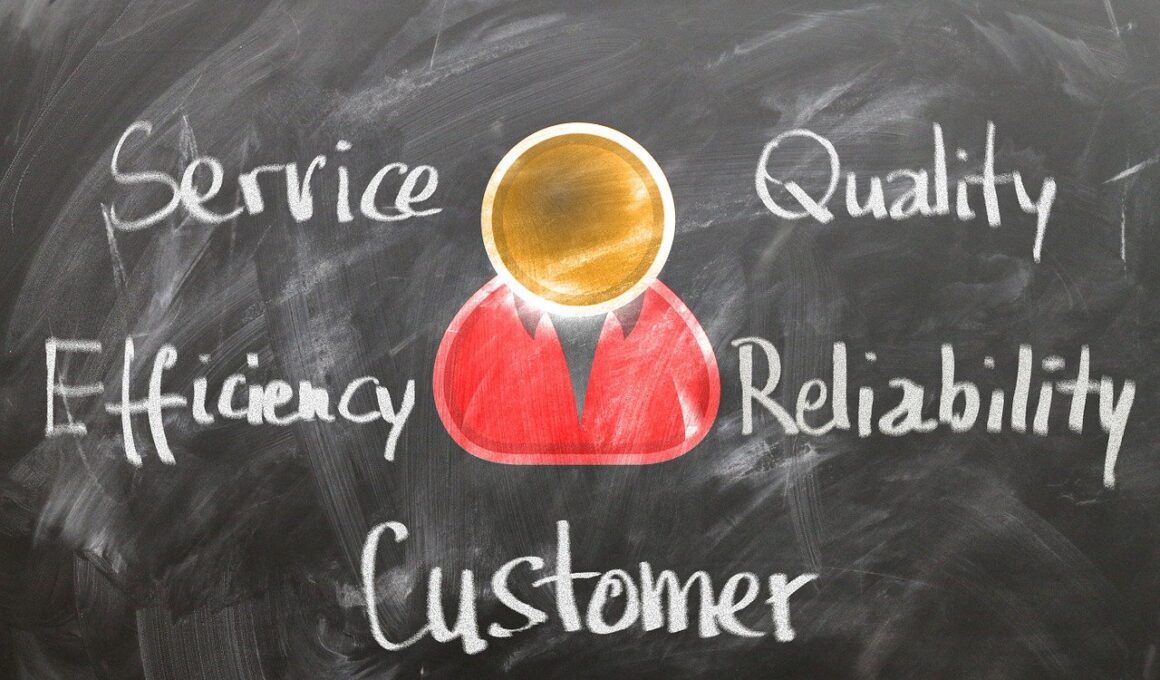Combining Qualitative and Quantitative Metrics for Retention Success
In today’s competitive business landscape, it’s important to leverage both qualitative and quantitative metrics. Organizations must prioritize understanding customer behavior, preferences, and overall satisfaction. This dual approach allows companies to gain insights that solely relying on figures cannot provide. Qualitative metrics include direct feedback, customer interviews, and open-ended survey questions. By analyzing this data, businesses can identify patterns that drive retention. Additionally, qualitative insights can help craft tailored marketing strategies. On the other hand, quantitative metrics involve numerical data such as customer lifetime value (CLV), churn rate, and net promoter score (NPS). These provide measurable targets. Combining these two metrics enables businesses to identify underlying issues, allowing for targeted interventions. Teams tasked with retention strategies often rely on these metrics to improve their approaches and make informed decisions. Understanding the balance between subjective opinions and objective data equips organizations to develop a comprehensive retention strategy. In this way, the synergy between qualitative and quantitative data leads to more effective decision-making as companies adapt to changing customer needs while fostering loyalty and satisfaction.
One critical quantitative metric to monitor is the churn rate. Churn, simply put, is the percentage of customers who stop using a service within a given timeframe. Companies must systematically track their churn rate to identify trends. Decreasing churn signifies effective retention strategies, whereas increasing churn indicates areas needing improvement. High churn rates can signal dissatisfaction, unmet expectations, or better competitors. To effectively reduce churn, businesses must analyze historical data, customer touchpoints, and service quality. This information can inform proactive measures to prevent customer loss. On the qualitative side, gathering customer feedback through interviews, reviews, or focus groups will reveal emotional drivers behind why customers leave or stay. Engaging with customers directly offers invaluable insights into their experiences. Surveys can also provide essential qualitative data, helping to understand what features or services are most desired. Moreover, segmented surveys can identify unique trends within customer groups. Combining churn rate analysis with qualitative feedback allows not only to understand how many customers leave but why they are leaving. This two-pronged approach initiates a feedback loop that informs ongoing improvements to retention strategies.
Another essential metric for assessing customer retention is the customer lifetime value (CLV). CLV estimates the total revenue a business can expect from a single customer throughout their relationship. Understanding CLV is crucial for developing marketing strategies aimed at retention. By knowing how much each respective customer relationship is worth, businesses can better allocate resources to retain customers. For instance, if the CLV is high, investing in personalized marketing and loyalty programs may pay off substantially. Conversely, if CLV is low, it may prompt a reevaluation of customer engagement strategies. To determine CLV accurately, businesses must analyze purchasing behaviors, the frequency of purchases, and average order value. It’s also critical to factor in customer acquisition costs. By understanding this metric’s financial implications, organizations can strategize accordingly. Tracking CLV over time provides insights into how effectively retention strategies are performing. A growing CLV often indicates successful strategies that engage customers. Conversely, a stagnant or declining CLV signals that adjustment is needed. Therefore, integrating qualitative feedback with CLV ensures a holistic view of customer retention efforts, identifying successful strategies and new opportunities for improvement.
Integrating Feedback Loops into Retention Strategies
Utilizing customer feedback effectively can significantly enhance retention strategies. Establishing a robust feedback loop fosters continuous improvement within organizations. This involves regularly soliciting input from customers through surveys, net promoter scores, or focus groups. The responses gathered serve as a crucial input for refining products and services. Businesses can use this feedback to make informed adjustments that resonate with customer expectations. Implementing strategies based on customer insights ensures that offerings evolve in line with changing preferences. Keeping communication channels open allows customers to feel valued, enhancing loyalty. Regular check-ins and active listening demonstrate a commitment to customer experience. Furthermore, analyzing trends in feedback can reveal areas of concern. Common suggestions or complaints indicate specific aspects that merit attention. Addressing these issues directly not only satisfies customers but also serves as a differentiator in competitive markets. By routinely reinforcing this feedback cycle, organizations can foster customer loyalty and improve retention. Ultimately, a focus on happy customers creates avenues for growth, extending not just existing relationships but also attracting new customers drawn in by positive word-of-mouth from satisfied users.
Retention strategies should incorporate both proactive and reactive measures. Proactive strategies aim to address issues before they lead to customer churn. This entails understanding warning signs, such as decreased engagement, and reaching out before customers opt to leave. Tools like customer relationship management (CRM) software can be valuable in this respect, analyzing customer behaviors. By identifying at-risk customers, organizations can intervene early with tailored offers or messaging. Alternatively, reactive strategies come into play once a customer has expressed dissatisfaction or chosen to leave. This phase often involves exit surveys and re-engagement campaigns tailored to take back lost customers. For instance, offering incentives or exclusive deals may entice former customers to return. However, the key to effective retention lies in striking a balance. While it may be easier to react to churn, being proactive can yield significant long-term benefits. Therefore, integrating qualitative insights with both proactive and reactive measures ensures a comprehensive approach. By understanding the emotional resonance behind customer decisions, organizations can tailor their retention strategies in a way that encourages loyalty and satisfaction.
Data-driven Decision Making for Enhanced Retention
Incorporating a data-driven approach to retention strategies can significantly enhance their effectiveness. This involves leveraging analytics tools to interpret trends and generate actionable insights from collected data. Businesses can utilize platforms that aggregate both qualitative and quantitative metrics for a comprehensive overview. Understanding customer segmentation helps to tailor communication and offerings to specific groups. For example, high-value customers might receive exclusive content or offers, while newer customers could benefit from onboarding resources. By analyzing data trends, businesses can identify which retention strategies yield the best results. Additionally, A/B testing different campaigns allows companies to assess what resonates with their audience. Moreover, correlational studies on customer behavior can help correlate satisfaction levels with service engagements, retention rates, and loyalty impacts. Regular data reviews yield insights into shifting market dynamics, creating adaptive strategies. Establishing key performance indicators (KPIs) aligned with business objectives fixes a clearer trajectory for success. The combination of qualitative insights with quantitative data creates a multidimensional picture that allows for better decision-making and adaptive strategies in customer retention.
Lastly, measuring success and refining strategies is paramount in effective customer retention efforts. Organizations must set clear benchmarks for success based on defined metrics. This can include retention rates, customer satisfaction scores, and net promoter scores. By continuously measuring these benchmarks, businesses can determine the effectiveness of their retention strategies. If certain strategies underperform, it is crucial to understand the underlying issues. Regular evaluation promotes ongoing adaptation and improvement that meet evolving customer needs. Additionally, creating accountability within teams that focus on retention strategies fosters a culture of excellence. Teams can celebrate their wins through data, creating motivation to achieve goals. Conversely, transparent discussions regarding challenges help in consolidating learning experiences for future strategies. Collaboration among departments, such as marketing and customer support, is vital to align overall objectives. As businesses gather comprehensive feedback both quantitatively and qualitatively, there’s room for continuous improvement. In this way, organizations can establish a trajectory for lasting relationships and repeated success, leading to enhanced growth and increased revenue from loyal customers.
To summarize, integrating both qualitative and quantitative metrics enhances customer retention strategies significantly. Organizations that adopt a balanced approach to data allow for deeper insights into customer behavior while targeting their emotional needs. Metrics such as churn rates and customer lifetime value are essential components of a data-driven strategy. However, complementing these with qualitative data strengthens understanding. A strong feedback loop and open communication with customers validate their experiences and expectations. These insights guide proactive measures, preventing churn, as well as reactive strategies aimed at recoveries. This holistic approach fosters long-lasting customer relationships, creating loyalty by addressing both rational and emotional aspects. Furthermore, data analytics enables teams to refine their efforts regularly, emphasizing successful areas of retention and identifying those needing improvements. Encouraging collaborations and synergies across departments will ensure a unified strategy fostering customer-centric practices. As customer expectations continue to evolve, companies that remain adaptable and responsive will succeed in fostering loyalty and reducing turnover. Prioritizing these metrics establishes a foundation for excellence in customer retention that promotes sustainability and profitability. Businesses positioned to listen and act upon their customers’ needs will thrive in a world characterized by rapid change.


